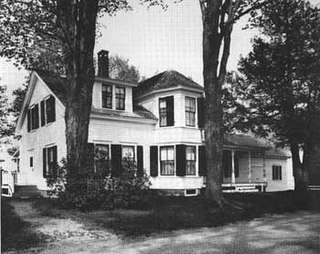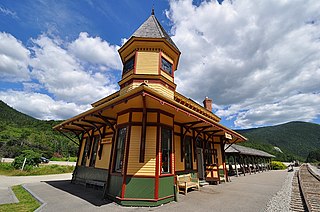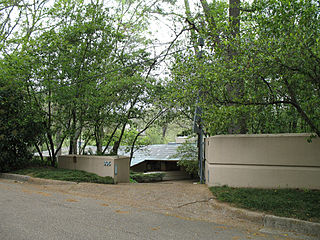
Freedom Summer, also known as Mississippi Freedom Summer, was a campaign launched by American civil rights activists in June 1964 to register as many African-American voters as possible in the state of Mississippi. Blacks in the state had been largely prevented from voting since the turn of the 20th century due to barriers to voter registration and other Jim Crow laws that had been enacted throughout the American South. The project also set up dozens of Freedom Schools, Freedom Houses, and community centers such as libraries, in small towns throughout Mississippi to aid the local Black population.

Johnson Wax Headquarters is the world headquarters and administration building of S. C. Johnson & Son in Racine, Wisconsin. Designed by American architect Frank Lloyd Wright for the company's president, Herbert F. "Hib" Johnson, the building was constructed from 1936 to 1939. Its distinctive "lily pad" columns and other innovations revived Wright's career at a point when he was losing influence. Also known as the Johnson Wax Administration Building, it and the nearby 14-story Johnson Wax Research Tower, also by Wright, were designated as a National Historic Landmark in 1976 as Administration Building and Research Tower, S.C. Johnson and Son. The Tower portion currently serves as a museum of Wright's design and company history, periodically open for public tours.

The Battle of Champion Hill of May 16, 1863, was the pivotal battle in the Vicksburg Campaign of the American Civil War (1861–1865). Union Army commander Major General Ulysses S. Grant and the Army of the Tennessee pursued the retreating Confederate States Army under Lieutenant General John C. Pemberton and defeated it twenty miles to the east of Vicksburg, Mississippi, leading inevitably to the Siege of Vicksburg and surrender. The battle is also known as Baker's Creek.

Lyndon B. Johnson National Historical Park is a United States National Historical Park in central Texas about 50 miles (80 km) west of Austin in the Texas Hill Country. The park protects the birthplace, home, ranch, and grave of Lyndon B. Johnson, 36th president of the United States. During Johnson's administration, the LBJ Ranch was known as the Texas White House because the President spent approximately 20% of his time in office there.

The Coolidge Homestead, also known as Calvin Coolidge Homestead District or President Calvin Coolidge State Historic Site, was the childhood home of the 30th president of the United States, Calvin Coolidge and the place where he first took the presidential oath of office. Located in Plymouth Notch, Vermont, Coolidge lived there from age four in 1876 to 1887, when he departed for Black River Academy for education. He is buried in Plymouth Notch Cemetery not far from the home.

Crawford Depot, also known as Maine Central Passenger Railway Station, is a historic passenger railroad station at the top of Crawford Notch in the Bretton Woods area of the town of Carroll, New Hampshire. Built in 1891, it is a surviving emblem of the importance of the railroad in the area's history as a tourist destination, and is one of the finest examples of Queen Anne railroad architecture in northern New England. Now home to a visitors center operated by the Appalachian Mountain Club, it was listed on the National Register of Historic Places in 1982. It is also the northern terminus of most trains on the "Notch Train" service of the Conway Scenic Railroad.

Fountainhead is a historic house located at 306 Glenway Drive in Jackson, Mississippi.

South Columbus Historic District is a historic district in Columbus, Mississippi that was listed on the National Register of Historic Places in 1982. Its 1980 nomination lists 525 structures and sites.

The A. P. Johnson House, also known as Campbell Residence, is a Frank Lloyd Wright-designed Prairie School home that was constructed in Delavan, Wisconsin, USA, in 1905. It was listed on the National Register of Historic Places in 1982.

The White Meetinghouse, also known as the First Freewill Baptist Society Meetinghouse, is a historic meeting house on Towle Hill Road, south of Eaton Center, New Hampshire. Built in 1844, it is a well-preserved and little-altered example of a vernacular Greek Revival meeting house. The building was listed on the National Register of Historic Places in 1980. The building is now maintained by a local community organization, and is used for community events and occasional services.

The George Tromley Sr. House is a historic building located in Le Claire, Iowa, United States. It has been listed on the National Register of Historic Places since 1979. The property is part of the Houses of Mississippi River Men Thematic Resource, which covers the homes of men from LeClaire who worked on the Mississippi River as riverboat captains, pilots, builders, and owners. It is also a contributing property in the Cody Road Historic District.

The George Tromley Jr. House is a historic building located in Le Claire, Iowa, United States. It has been listed on the National Register of Historic Places since 1979. The property is part of the Houses of Mississippi River Men Thematic Resource, which covers the homes of men from LeClaire who worked on the Mississippi River as riverboat captains, pilots, builders and owners.

The John R. Boyle House was a historic building located on the east side of Davenport, Iowa, United States. It was listed on the National Register of Historic Places in 1983, and has subsequently been torn down.

Peters’ Barber Shop is a historic building located in the West End of Davenport, Iowa, United States. It was completed in 1905 and it has been listed on the National Register of Historic Places since 1984.

The Roswell Spencer House was an historic property located in Pleasant Valley, Iowa, United States. The house was listed on the National Register of Historic Places in 1982. It has subsequently been torn down.

The Tallahatchie County Second District Courthouse is located in Sumner, Mississippi, in Tallahatchie County, Mississippi. The county courthouse was listed on the National Register of Historic Places on March 6, 2007. It is located at 108 Main Street. The two-story brick courthouse building was constructed in 1910 in a Richardsonian Romanesque architecture style with a four-story tower on one corner. It was the site of the September 1955 Emmett Till murder trial. It has been restored to its appearance at the time of the trial, "to house a museum dedicated to the memory of the events surrounding Emmett Till's murder and trial. The project was expanded to focus on all the sites associated with the events. A driving tour has been developed and marked." As of 2018 there is no museum in the Courthouse.

The E.A. Shaw House is a historic building located on the east side of Davenport, Iowa, United States. It has been listed on the National Register of Historic Places since 1984.

The Clark–Blackwell House is an historic residence located in Muscatine, Iowa, United States. It has been listed on the National Register of Historic Places since 1983. The house was included as a contributing property in the West Hill Historic District in 2008.

The Dawson Woman's Club was founded in 1905 as the "Wednesday Afternoon Club" and became a member of the Georgia Federation of Women's Clubs in 1907.

The Medgar and Myrlie Evers Home National Monument, also known as Medgar Evers House, is a historic house museum at 2332 Margaret Walker Alexander Drive within the Medgar Evers Historic District in Jackson, Mississippi, United States. Built in 1956, it was the home of African American civil rights activist Medgar Evers (1925–1963) at the time of his assassination. It was designated a National Historic Landmark in 2017. The John D. Dingell, Jr. Conservation, Management, and Recreation Act, signed March 12, 2019, by President Donald Trump, authorized it as a national monument; it was established on December 10, 2020, after the National Park Service (NPS) acquired it from Tougaloo College.





















